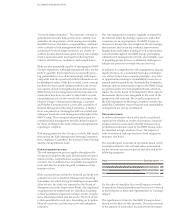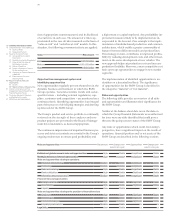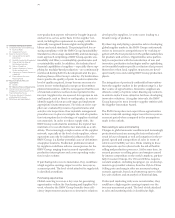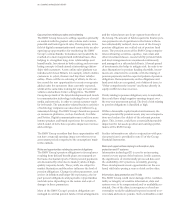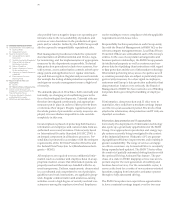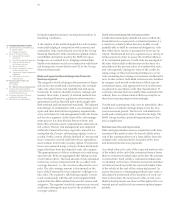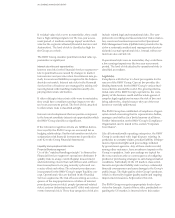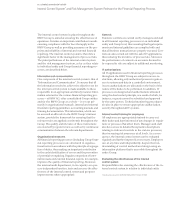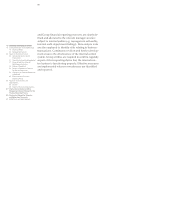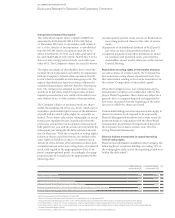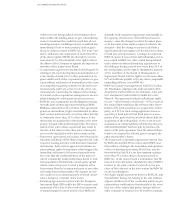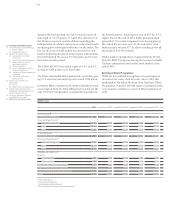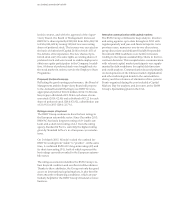BMW 2015 Annual Report Download - page 79
Download and view the complete annual report
Please find page 79 of the 2015 BMW annual report below. You can navigate through the pages in the report by either clicking on the pages listed below, or by using the keyword search tool below to find specific information within the annual report.79 COMBINED MANAGEMENT REPORT
If residual value risks were to materialise, they could
have a high earnings impact over the two-year assess-
ment period. A medium earnings impact would then
arise for the segments affected (Financial Services and
Automotive). The level of risk is classified as high for
the Group as a whole.
The BMW Group classifies potential residual value op-
portunities as significant.
Interest rate risks and opportunities
Interest rate risks in the Financial Services segment re-
late to potential losses caused by changes in market
interest rates and can arise when fixed interest rate pe-
riods for assets and liabilities recognised in the balance
sheet do not match. Interest rate risks in the Financial
Services line of business are managed by raising refi-
nancing
funds with matching maturities and by em-
ploying interest rate derivatives.
If risks relating to interest rate risks were to materialise,
they could have a medium earnings impact over the
two-year assessment period. The level of risk attached
to interest rate risks is classified as high.
Interest rate developments that are positive compared
to the forecast constitute interest rate opportunities which
the BMW Group classifies as significant.
If the relevant recognition criteria are fulfilled,
deriva-
tives used by the BMW Group are accounted for as
hedging relationships. Further information on risks in
conjunction with financial instruments is provided in
note 42 to the Group Financial Statements.
Liquidity and operational risks in the
Financial Services segment
Use of the “matched funding principle” to finance the
Financial Services segment’s operations eliminates li-
quidity
risks to a large extent. Regular measurement
and monitoring ensure that cash inflows and outflows
from transactions in varying maturity cycles and cur-
rencies offset each other. The relevant procedures are
incorporated in the BMW Group’s target liquidity
con-
cept. Operational risks are defined in the Financial
Services segment as the risk of losses arising as a conse-
quence of the inappropriateness or failure of internal
procedures (process risks), people (personnel-related
risks), systems (infrastructure and IT risks) and external
events (external risks). These four categories of risk also
include related legal and reputational risks. The
com-
prehensive recording and measurement of risk scenarios
,
loss events and countermeasures in the Operational
Risk Management Suite (OpRisk-Suite) provides the ba-
sis for a systematic analysis and management of poten-
tial and / or actual operational risks. Annual self-assess-
ments are also carried out.
If operational risks were to materialise, they could have
a low earnings impact over the two-year assessment
period. The level of risk attached to operational risks is
classified as medium.
Legal risks
Compliance with the law is a basic prerequisite for the
success of the BMW Group. Current law provides the
binding framework for the BMW Group’s various busi-
ness activities around the world. The growing interna-
tional scale of the BMW Group’s operations, the com-
plexity of the business world and the whole gamut of
complex legal regulations increase the risk of laws not
being adhered to, simply because they are either not
known or not fully understood.
The BMW Group has established a Compliance Organi-
sation aimed at ensuring that its representative bodies,
managers and staff act in a lawful manner at all times.
Further information on the BMW Group’s Compliance
Organisation can be found in the section “Corporate
Governance”.
Like all internationally operating enterprises, the BMW
Group is confronted with legal disputes relating, in
particular, to warranty claims, product liability, infringe-
ments of protected rights and proceedings initiated
by government agencies. Any of these matters could,
among other outcomes, have an adverse impact on the
Group’s reputation. Such proceedings are typical for
the sector and can arise as a consequence of realigning
product or purchasing strategies to suit changed market
conditions. Particularly in the US market, class action
lawsuits and product liability risks can have substantial
financial consequences and cause damage to the Group’s
public image. The high quality of the Group’s products,
which is ensured by regular quality audits and ongoing
improvement measures, helps reduce this risk.
The BMW Group recognises appropriate levels of pro-
vision for lawsuits. A part of these risks, particularly
re-
garding the US market, is insured where this makes


